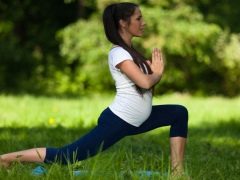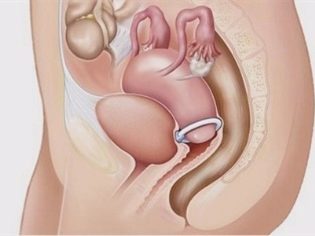Gymnastics for pregnant women in the second trimester
Adequate physical activity during pregnancy is the best preparation for the upcoming birth, but in different gestational terms, the demands are made to the load. How to do gymnastics in the second trimester, will be discussed in this material.
Why do you need it?
The second trimester of pregnancy, starting with the 14th obstetric week, is considered the best time to start physical activity. In the first trimester, the female body adapts to the new situation, and this adaptation does not always proceed smoothly and easily, many suffer from toxicosis, the threat of miscarriage is often encountered, and therefore experts do not recommend in the early stages to exercise themselves.
Quite another thing - the second trimester. The state of health improves, there is no severity yet, toxicosis recedes, the primary adaptive reactions of the female body are successfully passed. It's time to start to gradually engage in to keep fit. The risks of miscarriage, missed abortion in the second trimester are decreasing every day.
Women who systematically do at least exercises with the complex of exercises resolved in the “interesting position” feel better, it is easier for them to carry the baby in the final, third trimester of pregnancy, all muscle groups are better prepared for the birth process.
It is not necessary to engage in an expensive group in the fitness center, it is not necessary to do it professionally. Gymnastics for pregnant women is a very democratic concept, it can be done at home, alone. It is only important to give it the right value.
The obvious benefit of charging for pregnant women lies in the fact that all the organs and systems of the future mother begin to work better, metabolism improves, and therefore the woman does not gain extra pounds, which can worsen the course of the third trimester and childbirth. Protective functions of the body are enhanced, and the muscles become more elastic, better supplied with blood.
Gymnastics allows you to more effectively master proper breathing, which will make it easier to survive contractions and naturally anesthetize the birth process. And besides:
- helps regulate and maintain normal blood pressure levels;
- helps to reduce the load on the spine, its more even distribution, relief of pain in the back and lower back, which are characteristic of the second half of the second trimester;
- reduces swelling.
Women who were engaged in physical exercise during the carrying of a baby, recover faster after childbirth, come into shape faster, restore the state of the abdomen and reduce weight to the original.
A particular danger during pregnancy is prenatal depression. Gymnastics allows you to improve the psycho-emotional state, protects a woman from dark and dangerous thoughts. The fact is that prenatal depression very often results in severe forms of post-genital depression. Therefore, adequate charging is an excellent prevention.
Contraindications
Despite all the benefits of gymnastics for pregnant women, there are conditions and complications of pregnancy that do not imply an increase in physical activity in the interests of the mother and fetus. Reasons that should force a woman to stop charging and gymnastics in the 2nd trimester:
- the appearance of pronounced edema in combination with high blood pressure and the presence of protein in the urine - with preeclampsia in the second trimester, the woman shows rest and inpatient treatment;
- low placenta previa, placenta previa - exercise can lead to detachment, bleeding and death of the fetus;
- increased tone of uterine muscles (the causes of hypertonus can be any, but the recommendation is always universal - spasmolytics and rest);
- heart and kidney disease in the future mother;
- cold or viral disease in the acute period, any discomfort - charging can be returned only after the condition is normalized;
- isthmic-cervical insufficiency (violation of the locking function of the cervix).
With particular care to gymnastics, gymnastics and other types of physical activity should include women who have previously suffered a miscarriage or premature birth in the second trimester. If there is an unusual discharge, a woman has hemorrhoids, varicose veins is aggravated, or severe anemia is detected according to the results of tests, it is recommended to postpone physical exercises until the state of the body returns to normal.
Begin to engage in gymnastics should only be after consultation with the obstetrician-gynecologist. In the 2nd trimester, all women are registered in consultation, so the question will be easy to ask at the next visit to the doctor.
If there are no contraindications, neither the baby nor his mother is in danger, the doctor will only support such a desire of the pregnant woman.
What types of loads are allowed?
In the second trimester, the woman's uterus ceases to fit in the pelvis and begins to gradually rise into the abdominal cavity, above. The tummy grows, and by the middle of the second trimester it will be impossible to hide it. And it will be necessary to reckon with the growth of the tummy from 14 weeks and even earlier - you cannot lie on your stomach because of the risk of squeezing the uterus, you cannot lie on your back because of the risk of aortocaval compression, in which the uterus pinches the aorta and the lower full vein.
Considering that the state of a woman changes every day, during this period it is recommended to choose such types of loads:
- yoga;
- exercise on fitball;
- fitness for expectant mothers;
- Pilates;
- breathing exercises;
- water aerobics;
- swimming.
Important! The general rule of employment for women in the second trimester does not imply training for more than 30 minutes.
When choosing one or another type of gymnastics or physical therapy for pregnant women, the trimester features, physiological changes and risks of this period are necessarily taken into account, and therefore are strictly prohibited:
- Weightlifting;
- exhausting fitness on simulators;
- power and aerobic exercises;
- jumps, including in water, in length;
- exercises for abdominal muscles;
- all complexes and exercises in which a woman needs to be balanced with support for one leg (there is a risk of falling and getting injured);
- intense running
Even if a woman was engaged in extreme sports, jumped with a parachute or engaged in glider sports before pregnancy, now is not the right time for such a load. The release of stress hormones (in particular, adrenaline) can significantly change the balance of sex hormones, which can cause late miscarriage, premature birth, placental abruption.
Everything that a woman will do must be completely safe and as helpful as possible.
Safety regulations
There are "golden" rules for the safety of any physical activity while waiting for a child. First of all, all the exercises that are included in one or another complex should be performed smoothly and carefully, no abrupt movements should be allowed. Even those exercises that involve waving legs or arms should be performed as gently as possible.
To make the session safer and more comfortable, it is recommended to adhere to such measures.
- Wear a antenatal bandage.If at 14 weeks of pregnancy you can still do without it, then by the 25th week and later without the support of the growing tummy is not enough.
- Choose supporting underwear from natural fabrics. It will additionally help support the muscles and the skin beneath it will not sweat.
- Buy an inexpensive pulsomer - it is very important to monitor the heart rate during exercise. If the pulse is too frequent, it can adversely affect the state of uteroplacental blood flow.
- Between the exercises, take a break to give yourself the opportunity to fully restore the pulse and breathing.
- Tune in psychologically and emotionally for training with pleasure. If for some reason you don’t want to do it now, do not force yourself, do not try to show everyone around you what a strong-willed person you are. Training through force will not bring positive emotions and will not be as useful as voluntary ones.
If while performing a set of exercises for pregnant women, the woman felt dizzy, headache, any other discomfort, she should immediately stop exercising and give herself a rest. If the condition does not return to normal, seek medical attention.
Simple exercises at home
Plus home gymnastics for pregnant women - in the simplicity and no need to pay for the services of a fitness trainer or an exercise therapy specialist. Gymnastics at home does not take much time, you can do it at any free time and for this it is completely unnecessary to go somewhere or go. It is optimal to conduct such a gymnastics in the morning when the woman is still full of energy.
Let's start with a warm-up:
- lift your arms up, gently reach for them up, lower your arms and relax;
- spread your arms to the sides, gently stretch them to the right and left several times;
- sitting on the floor or on a gymnastics mat, fold your legs “in Turkish”;
- straighten your back and start making slow and smooth turns with your head and body to the right and left side;
- rotate hands in a circle, starting with the hands and gradually drawing the elbows and shoulders into the rotation.
At the end of the warm-up, the woman needs a little rest (about 2-3 minutes), breathing is restored, after which you can proceed to the basic exercises.
- Push-pull. Starting position - sitting on the floor. The back is straight. Keep your elbows at the level of the pectoral muscles. First, with the right palm, press on the left and move your hands to the appropriate side, and then with your left palm, press on the right.
- "Chinese fan". Starting position - lying on its side. Hands should be pulled forward. The limb, which is on top, should be smoothly retracted by 180 degrees, and with it the body should be rotated smoothly. To perform the exercises on the other side, you need to lie on the other side.
- "Samovar". Starting position - sitting on the floor. Bend your legs so that your buttocks lie on your feet. Spread your knees, place the tummy comfortably between them. Do smooth bends forward and smoothly return to its original state.
- "The traffic controller." Starting position - sitting on the floor. Lean backwards. Straighten and bend your legs, push them apart and bring them together again. Do not forget to do all this very smoothly.
- "Cat". Starting position - standing on the floor on all fours. Tilt your head back, gently take a deep breath, bend your back. Exhale, bend the back of the "hill" and tilt your head down.
These exercises for pregnant women will be especially useful if you supplement the complex with a walk in the fresh air with a peaceful step.
How to practice fitball?
From the second trimester of pregnancy, the baby is actively growing, which creates an increased load on the spine of the expectant mother. Because of this, back and waist pain. To reduce the discomfort and relieve the spine, it is recommended a set of exercises on fitball. A special gymnastic ball today is not uncommon, it is inexpensive and can be purchased at any sporting goods store.
Exercises on the ball can be a separate complex, as well as an addition to the general gymnastics described above. In addition, fitball can be of great help during fights - many women admit that it was easier for the ball to endure the first stage of labor.
In the second trimester, not all the features of a fitball a woman can use. Only exercises are available, the initial position in which is sitting on the ball. From this position, the following exercises are allowed.
- "Pendulum". The back is straight, arms outstretched and resting on the legs. A woman leads her head to the right and left shoulder alternately, and also turns her head to the right and left.
- "Yula". Hands to the side, the woman makes smooth turns torso in the right and left sides.
- "Wings". The arms are retracted to the sides and joined at the back, while the shoulder blades are closed.
Another position allowed during pregnancy is lying on the floor with legs raised on a fitball. For a long time in this position can not lie. Roll the ball with your feet in a circle - this will be an excellent prevention of leg edema and varicose veins.
Another embodiment of the exercise with the fitball - lying on its side. A woman throws her upper leg on the ball and makes arc-shaped and circular rolling of the ball. It helps to train the muscles of the legs and pelvis.
Yoga classes
The poses in yoga are called "asanas". They exist a great many. Pregnant women in the second trimester need to choose only those asanas, which are aimed at strengthening the muscles of the pelvis, back. Prepared pelvic muscles - a pledge of light and non-traumatic labor.
The difficulty lies in the fact that for women who are not familiar with yoga in general, it is impossible to cope with the first classes without an instructor - the exercises must be shown by a specialist. Asanas should be used with great caution, with an inept or unwise approach, they can harm the health of the baby and the expectant mother. Here are some poses that are recommended during pregnancy.
- Sitting on the floor, the woman straightens her back, crosses her feet, flexes her legs at the knee joints. Hands gently raises above his head and begins to slowly and gently sink to his back. After a few minutes of lying down, she rises and again assumes the starting position. Lifting is carried out in an arbitrary way, it is not necessary to do it in the same way as lowering occurred - this will create an increased load on the abdominal muscles.
- Sit comfortably on the floor while seated, bend the legs at the knee joints and with the inside of the knee to the floor, spread your legs apart. So w-shaped sometimes sit small children. Pull the foot to the buttocks and gently release them. Do this pull up a few times.
- Sitting on the floor, legs together. Put your palms on your hips. Straighten your back to the "chord", keep your neck and head even. Sit in this position for about a minute and give yourself the opportunity to relax, “limp”. After resting, repeat the exercise.
Whatever asanas would be chosen, it is worth working out proper breathing. Yoga is also useful because it is a successful combination of respiratory and physical activity. Breathe evenly, deeply, breaths should be slow, exhalations - even more prolonged.
Such breathing then helps in childbirth. And while the second trimester is underway, combining this type of prolonged breathing with simple asanas will help improve blood circulation and well-being.
Kegel complex
Exercises for training the muscles of the pelvic floor - an excellent preparation for childbirth. But the complex has its own contraindications. Thus, it is forbidden to conduct such exercises for pregnant women with isthmic-cervical insufficiency, placenta previa, and the threat of premature birth. Be sure to consult a doctor before starting training.
In the second trimester, a woman can use the following techniques.
- The tension of the muscles of the perineum and keeping them in a tense state for 10 seconds. Gradually hold time can be increased.
- Alternating muscles of the perineum and anus.
- Gradual tension of the vaginal muscles from the bottom up and from top to bottom.
- In the sitting position with legs crossed, you need to slightly tighter and relax. At the potent reception inhale, on relaxation - exhale.
- Raising the pelvis from the supine position with simultaneous short-term tension of the muscles of the perineum, while lowering the pelvis muscles relax.
Important! Breathing during kegel exercises is not delayed, it should be measured, deep and calm.
Overwork when performing such exercises is not worth it. Increase the number of approaches and the duration of the exercise gradually. If necessary, rest, relax. Do not get too carried away with the Kegel complex - 2-3 minutes per day is enough. With these exercises, if there are no contraindications, you can effectively supplement the exercises of general gymnastics.
Breathing exercises
The complex of breathing exercises a woman can combine with any kind of physical activity or use separately. If a woman has contraindications to the physical exercises described above, then there are almost no contraindications for breathing exercises, and doctors usually approve of them.
Proper breathing makes it easier to survive contractions and attempts, it naturally relieves the generic process.
If there is no generic experience, it is better to take at least one lesson of proper breathing from a specialist. It is not necessary to pay big money - in every antenatal clinic there are courses for expectant mothers, where they will tell you the basic breathing techniques for free. Then at home you can train yourself.
Pay attention to the following exercises.
- Breathe like a dog. Frequent superficial breaths and exhalations with an open mouth. The main thing is to breathe in and out at the same time with your mouth and nose.
- Long breaths and short exhalations. Take a long chest breath (the abdomen remains motionless with it) and a short exhalation.
- Long breaths and long breaths. Take a deep breath on the score 1-2-3-4, and exhale should be done on the score 1-2-3-4-5-6.
- Long breaths and "ragged" exhalations. Take a deep breath and start intensively pushing the air out through your mouth in small portions - this is how you extinguish the candle. Just imagine that there are many candles in front of you.
- Long abdominal breath (chest is immobile) and long and short (alternately) exhalation by the abdomen.
Important! Do breathing exercises in a relaxed, calm, focused. If you practice correct breathing for 15 minutes every day from the second trimester, for childbirth, correct breathing will be obtained reflexively, of course, which will significantly alleviate the condition of the woman.
Useful tips
Simple tips will help to make lessons more useful.
- Never do this or that exercise just because others praise it. If you personally exercise exercise discomfort, you do not need to force yourself, no matter how useful the exercise.
- You should not experiment and complicate the proposed exercises, for example, burdening them with dumbbells or home exercise equipment - this may instead cause good harm.
- Your health care provider should be aware of your exercises. He will help to adjust the level of physical activity individually, as well as warn about the "critical" periods of your pregnancy when the load is undesirable in principle.
- If the weather permits, exercise in the fresh air. If it is winter outside, be sure to ventilate the room before warming up and exercising.
If there are no contraindications, try to make your own complex of the proposed exercises, which will be comfortable just for you: keep in mind that the workout share in it should be no more than 15% of the time, the share of basic exercises - no more than 40%. For Kegel exercises, leave 15% of the time, dedicate the rest to yoga and breathing exercises.
It is also important to maintain your form throughout the day. If a woman does exercises in the morning and does yoga, and then spends the whole day on the sofa in front of the TV, you can’t count on the great benefits of physical exertion.
Walk, move, do what you can do with your homework - your muscles should be kept in good shape throughout the day.
Charging option for pregnant women in the second trimester, see the following video.





























